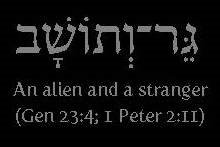 Next time a stranger at a bus stop walks up to you and asks, "What's your sign?" consider taking a cue from the Byzantine chronicler, Cedrenus (see here and here), and steer the conversation in a more interesting direction by responding, "Leo. What's your plague?"
Next time a stranger at a bus stop walks up to you and asks, "What's your sign?" consider taking a cue from the Byzantine chronicler, Cedrenus (see here and here), and steer the conversation in a more interesting direction by responding, "Leo. What's your plague?"Here's why: In his short summary of the 10 plagues narrated in Exodus 7-12, Cedrenus adds a new element by sequencing the plagues with the months of the year:
June - Water turned to bloodI don't know where Cedrenus got the idea of identifying the month on which each plague occurred. The summary passage in Cedrenus is listed as a parallel to the summary in Jubilees 48.5 by Denis, although Jubilees doesn't tie the plagues to specific months. Here's the Jubilees passage:
July - Frogs
August - Lice (see LXX)
September - Dog flies (see LXX)
October - Destruction of cattle
November - Blistering abscesses
December - Hail
January - Locusts
February - Darkness for three days
March - The Firstborn
April-May - Gigantic Fish (just kidding). If you were born in April or May I guess you get off easy.
"And the LORD executed great vengeance upon them on account of Israel. And he smote them with [1] blood, and [2] frogs, and [3] lice, and [4] dog flies; and [6] evil boils which break out (as) blisters; [5] and their cattle with death; and [7] hailstones with which he destroyed everything which sprouted up for them; and with [8] locust who ate the remainder which was left from the hail; and with [9] darkness, and (with death of) the [10] firstborn of men, and cattle; and upon all of their gods the LORD took vengeance and he burned them with fire." (Jub. 48.5; Wintermute's trans. in OTP; numbers in brackets refer to the biblical plague order)I wondered, since Jubilees explains that the plagues were God's judgment on the gods of Egypt, whether Cedrenus is also criticizing the Zodiac (but then what about the remaining two months?). But I think it is more likely that Cedrenus (or his source) worked backwards from the plague on the firstborn, now associated with the feast of Passover, as Passover sometimes begins toward the end of March. If you assume that each plague took a month to complete, Cedrenus's sequence works out.
 (The pictures are from my fishing outing with D&D last weekend at Buffalo Pound. I caught nothing, but came back with two large Northern Pike, thanks to the generosity of D&D. The one pictured above was a whopping 39 inches long! Both fish were still flapping, gasping, and extremely slimy when I got home and summoned t. to help me figure out how to "clean" them. We are still recovering from the experience.)
(The pictures are from my fishing outing with D&D last weekend at Buffalo Pound. I caught nothing, but came back with two large Northern Pike, thanks to the generosity of D&D. The one pictured above was a whopping 39 inches long! Both fish were still flapping, gasping, and extremely slimy when I got home and summoned t. to help me figure out how to "clean" them. We are still recovering from the experience.)

No comments:
Post a Comment